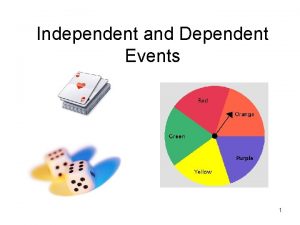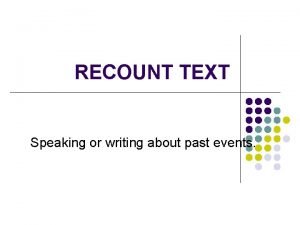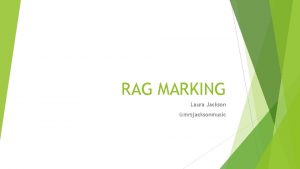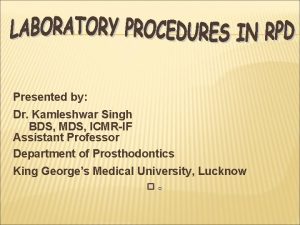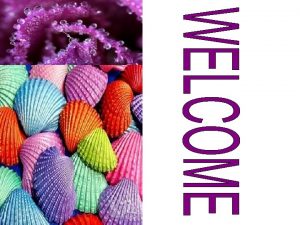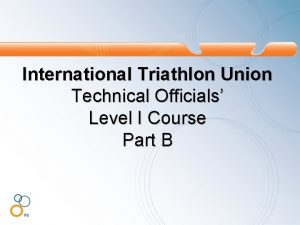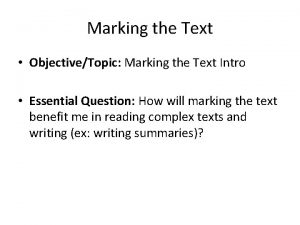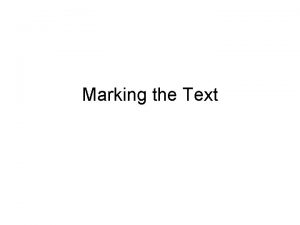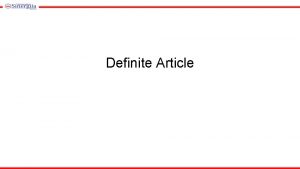Current Event Article Marking A marking text method


































- Slides: 34

Current Event Article Marking A marking text method

Marking the text. § This method will help you to thoroughly understand an article or some current event that you read. § In this class, you will be given various articles to read and mark. § This method can also be used to mark a text book or other book you read. § If you cannot write on the article or book itself, adapt this method with post-it notes.

Getting started Find the article Cut it out Prepare the article for marking Read the article

Choose your article Sometimes you will choose the article or passage you want to read. Sometimes the teacher will choose the article for you

Prepare the article Sometimes you will have to cut the article out and glue it onto a page so you can mark it. Sometimes that is not necessary. This article was cut out from a magazine and glued to a paper

Read the article § Read the article through once. You don’t have to do much else. § Just read it thinking about what the main idea is and making mental notes about vocabulary. § Did you understand all of it? § Also think about what is going through your head. What ideas, no matter how random, do you think about?

Choose the colors you will use for marking § You will need 3 colors, at least, for marking. § The colors can be highlighters, colored pens, crayons, colored pencils, etc. § Vocabulary § Annotations § Main Ideas and Summary § (optional) Reflection/Response § Make a key labeling the colors and the items they represent

Vocabulary Mark the words for vocabulary Write a definition

Vocabulary § Now that you have read the article once, go back through and mark vocabulary words. § You can highlight the words, or if you are using colored pens or other thinner utensil put circles or boxes around the words

Vocabulary marking I chose the color blue to highlight the words. You must mark at least 5 words. You can always mark more!

Vocabulary (continued) What words do you mark for vocabulary? The obvious words to mark are words you don’t know, but what if you know all the words in the article? § Words you’ve never heard of § Words you don’t know the meaning of § Words you’re not sure about § Words you can’t give a definition for § Words you know when you read but never use when you speak or write You should probably be able to find enough words now!

Vocabulary (continued) Write short definition of the words you choose § Write the definition in the margins or § Write the definitions all together in one area § If you can’t write on the article, writing the definitions in one area of your paper is a good option. § I chose option one for my article as seen in the next slide

Vocabulary Definitions Notice that I started to make my key in the corner. The words are highlighted and the definitions are outlined in that same color.

Re-Read the Article Now that you know what the words mean, re-read the article. Does the article make more sense? Do you get a better idea of the meaning now?

Annotations What random things go through your head as you read the article? What connections can you make to your life?

Annotations Make annotations in the margins (at least 5 notations) § These notations are about individual sentences or passages in the reading, not about the whole article. § Write a question you may have about the reading § Make a comment on the reading § Write an opinion about something in the text § Use the annotation/response starters from the Cornell Note-taking notes if needed. § As with the definitions, if you can’t write on the article itself, write the annotations in one area of your paper labeled as such. § You should write whatever pops into your head! These can be very profound thoughts!

Annotations I used a different color and shape to differentiate between the vocabulary and annotations. I have also added the annotations to the key.

Main Ideas What are the main ideas that the author wants you to understand?

Main Ideas § Using a different color, highlight or underline the main ideas of the article. § This is not just the one main idea of the article, the main ideas can also include the supporting ideas, too. § You will be using these ideas to write a summary later so get enough information.

Main Ideas I underlined the Main Ideas in green and marked it on the key. If you can’t write on the article, write the main ideas in a separate area marked for such.

Summary and Reflection/Response Paragraphs What was the article about and what did you think about it?

Summary Paragraph § Use the main ideas to write this paragraph § Don’t write, “The article is about. . . ” § The summary paragraph should be a condensed version of the article without all the fluff.

Response Paragraph § Evaluate the article (either the writing or the information). Did you like it? Was it interesting? Did you learn something? § How does this article tie in with what you’re learning in one of your classes? Does it tie in with something you have learned previously in another class? Did you study this or something similar in elementary or mid school or in a previous high school class? § What does the subject matter make you think of? Does it remind you of something you have seen or experienced in your life? Did you read a book on the subject or a similar subject? Maybe you watched a TV show that ties in with that subject. § What are your thoughts about the article/subject? Reflect on the article and bring something of YOU to your response. § Respect your audience and make them care. Be honest about your writing. Let your personality shine, but be appropriate and accurate (NO TEXT SPEAK!) Write memorable things that stand out. Be energetic but keep it under control.

Summary and Response Paragraphs

The Complete Article

Application § Reading the article just once or before understanding all the words and meanings can leave you with false ideas or an incomplete understanding of what the author is trying to say. § Now looking at the article after you have marked it you can understand so much more. § This method can be adapted to reading difficult text books, or other assigned reading from your teachers. § Most good readers already do a form of this method. They may not write everything down but they are doing the same techniques in some form.

Quick Outline of what we learned and how this is graded: § Find 5 vocabulary words, at least; write the definitions for each § Mark 5 passages and write 5 annotations about them, at least! § Highlight main ideas, enough for a summary § Write a Summary paragraph at least 5 sentences long § Write a Response paragraph sentences long at least 5 § 5 points § 5 points Ø 25 total points v. Be sure your heading and a key for colors is on the page. possible

Examples Here are some students’ work






 Making connections
Making connections Kcl mesh analysis
Kcl mesh analysis Perbedaan current rate method dan temporal method
Perbedaan current rate method dan temporal method Sentinel near miss reporting
Sentinel near miss reporting Simple and compound events examples
Simple and compound events examples Independent event vs dependent event
Independent event vs dependent event Independent and dependent probability
Independent and dependent probability Event planning swot analysis of event organizer
Event planning swot analysis of event organizer Bridge breaks in central java killing 5
Bridge breaks in central java killing 5 Town contaminated moscow
Town contaminated moscow Line current and phase current
Line current and phase current Line vs phase voltage
Line vs phase voltage Energy band diagram of pnp transistor
Energy band diagram of pnp transistor Lesson 4 three-phase motors
Lesson 4 three-phase motors Drift current and diffusion current in semiconductor
Drift current and diffusion current in semiconductor Drift current and diffusion current in semiconductor
Drift current and diffusion current in semiconductor The value of vgs that makes id approximately zero is the
The value of vgs that makes id approximately zero is the Balanced wye delta connection
Balanced wye delta connection Holding current and latching current
Holding current and latching current Drift current density unit
Drift current density unit In generators the welding current is produced on the ____.
In generators the welding current is produced on the ____. Hazard based safety engineering
Hazard based safety engineering Symposium method of teaching
Symposium method of teaching Writing about past events
Writing about past events Mesh current method
Mesh current method Mesh current method
Mesh current method Current rate vs temporal method
Current rate vs temporal method Automated exam marking
Automated exam marking National 5 pe understanding standards
National 5 pe understanding standards Rag marking
Rag marking Tripod marking in rpd
Tripod marking in rpd Tripod marking in rpd
Tripod marking in rpd Formal and informal replies
Formal and informal replies Triathlon body marking
Triathlon body marking Helicopter winching area marking
Helicopter winching area marking






